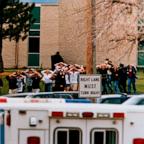Air Force Blames Oxygen-Deprived Pilot in Deadly F-22 Crash
Capt. Jeff Haney was killed in a crash in November 2010.
Dec. 15, 2011 — -- The U.S. Air Force is blaming an F-22 fighter pilot for the crash that cost his life, even though the plane -- one of a fleet plagued by oxygen system problems and never flown in combat -- malfunctioned, causing "severe restrictive breathing" and basically suffocating him as his jet flipped over and slammed into the ground in the Alaskan wilderness.
Capt. Jeff Haney was on a training mission in Alaska in November 2010 when his F-22 Raptor alerted him to a malfunction that cut off his oxygen supply, according to an investigative report released by the Air Force late Wednesday. Unable to breathe, Haney, a veteran and award-winning aviator, appeared in control for a few seconds as he took the plane to a lower altitude, but then the plane whipped into a radical roll that caused his jet to flip over and plummet to the ground. As he was falling, Haney didn't appear to fight the dive at all until the last second, too late to save his life.
"During the [mishap sortie], the [mishap pilot] most likely experienced a sense similar to suffocation when airflow to the oxygen mask stopped," the report says. "This was likely the [pilot's] first experience under such physiological duress. The unique and added stress of the breathing restriction contributed to the [pilot's] channelized attention."
Despite acknowledging the critical system failure, the Air Force blamed the crash on the pilot's "channelized attention," saying he was too distracted by his inability to breathe and should have focused on flipping on an emergency oxygen system and pulling the plane out of its dive.
"By clear and convincing evidence, I find the cause of the mishap was the [pilot's] failure to recognize and initiate a timely dive recovery due to channelized attention, breakdown of visual scan and unrecognized spatial disorientation," the president of the investigation board, Brig. Gen. James Browne, said in conclusion.
Known Issues with F-22 Oxygen Supply
Potential problems with the F-22 oxygen system were known to the Air Force two years before Haney's death. Starting in 2008, the Air Force said its pilots have experienced "hypoxia-like symptoms" mid-flight in at least 12 separate incidents. Hypoxia is characterized by a lack of oxygen flow to the brain and can cause dizziness, confusion and poor judgment. Despite having little or no oxygen for more than a minute, Haney did not suffer from hypoxia, the new report says.
The entire fleet of F-22s was grounded in May 2011 for five months as the Air Force investigated the breathing problem, but it was never solved and eventually the military cautiously allowed the Raptors back in the air. Not long after, however, another pilot reported hypoxia-like symptoms, prompting a smaller, temporary "pause" in operations at two F-22 bases.
But just because they're back in the air, doesn't mean they're going back to combat.
In fact the planes, which cost the U.S. government $77 billion for a fleet of 187 jets and went operational in December 2005, have never been used in active combat operations despite the Air Force's involvement in major combat operations from Iraq and Afghanistan to Libya. In every case, the Air Force said the jets, which are designed to fight other next-generation stealth fighters and not third-world insurgents, simply weren't an operational necessity.
READ: The $77 Billion Fighter Jets That Have Never Gone to War
The Mysterious Death of Fighter Ace Capt. Jeff Haney
Though the Air Force report gives a detailed, minute-by-minute account of Haney's last moments through recovered flight data, it leaves several key questions unanswered.By the Air Force's account, Haney's squadron had just completed an unremarkable training mission on the evening of Nov. 16, 2010 when Haney's plane detected a "bleed air leak" in a critical oxygen system. The malfunction triggered a sequence that cut off oxygen to Haney's mask.
Haney took the plane to a lower altitude and then, curiously, entered a radical 240 degree roll and started falling fast. For approximately the next 15 seconds, "there were no stick inputs and only very minor pedal inputs," the report says, referring to the aircraft's controls.




